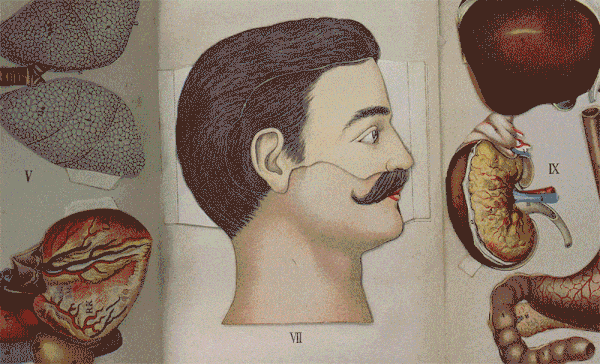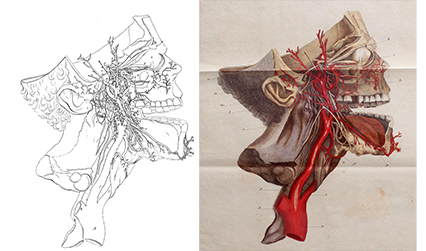Our new, 6-week, ‘pop-up’ exhibition Under the skin: illustrating the human body opened to the public on Friday 1 February.
The exhibition is part of the Thinking 3D project and it explores the variety of ways in which physicians, surgeons, artists and printers have tried to represent the three-dimensional human body on the two-dimensional page.

The exhibition launch coincides with the annual Color Our Collections festival of colouring-in in libraries organised by the New York Academy of Medicine Library, and the exhibits in Under the skin provide wonderful starting points for colourful interpretation.
Many of the books and drawings on display use colour as an integral part of their representations of the body, such as an edition of Albrecht Haller’s Icones anatomicae, which uses bright red and dull blue to show the arteries and veins of the head and neck. Some editions include a line-drawn version keyed to the text, to help the reader identify the different parts of the diagram.

Others were designed to be seen in black and white, such as the famous woodcuts in Andreas Vesalius’ De humani corporis fabrica (1543) or its precursor, Jacopo Berengario da Carpi’s Isagogae breves (1523). The careful use of line in these wood blocks create a powerful sense of the texture and shape of the human muscles. They’re also a great starting point for some colourful self-expression.

You can download the RCP colouring book from Color Our Collections, or come along to our Museum Late on Thursday 7 February. The exhibition will be open until 8pm, and we’ll have colouring sheets, pens, pencils and crayons all ready for you to express your creativity. Share your masterpieces online with the hashtags #colorourcollections and #RCPundertheskin.
Katie Birkwood, rare books and special collections librarian
- Come and colour our collections at the Museum Late on Thursday 7 February. Free entry and we’ll provide all the materials.
- Under the skin: illustrating the human body runs until Friday 15 March at the Royal College of Physicians, London.
- Color Our Collections is organised and run by the New York Academy of Medicine Library, and runs from 4 to 8 February 2019.
- Thinking 3D is an interdisciplinary exploration of the concept of three-dimensionality and its impact on the arts and sciences.
